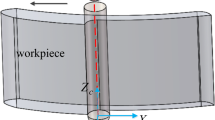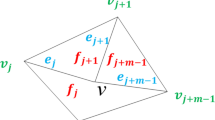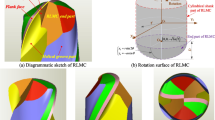Abstract
This paper presents a new approach to design a form milling cutter for precisely obtaining the complex free-form surfaces. In this study, the intersection point of the rake surface, helix flute and clearance flank is appropriately defined due to its significant role in the design and grinding performance. The angle-solid-block analysis is developed to establish the new cutter geometry model. Hence, a new form-milling cutter satisfying the requirements of machining characteristics of workpiece can be designed. In addition, the cutter geometric model can be adopted to map out the measuring strategy with minimum measured points to attain the exact geometric feature of cutter.
Similar content being viewed by others
References
Wu SM, Chen JM (1983) Mathematical model for Multifacet drills. ASME J Eng for Industry 105:171–181
Glaeser G, Wallner J, Pottmann H (1999) Collision-free 3-axis milling and selection of cutting tools. Comp Aided Design 31:225–232
Baptista R, Antune Simões JF (2000) Three and five milling of sculptured surfaces. J Mat Process Technol 103:398–403
Lee YS, Chang TC (1995) 2-Phase approach to global tool interference avoidance in 5-axis machining. Comp Aided Design 27:715–729
Yoon JH, Pottmann H, Lee YS (2003) Locally optimal cutting positions for 5-axis sculptured surface machining. Comp Aided Design 35:69–81
Park SC, Choi BK (2000) Tool-path planning for direction-parallel area milling. Comp Aided Design 32:17–25
Park SC (2004) Sculptured surface machining using triangular mesh slicing. Comp Aided Design 36:279–288
Park SC (2003) Tool-path generation for Z-constant contour machining. Comp Aided Design 35:27–36
Tsai WD, Wu SM (1979) A Mathematical Model for Drill Point Design and Grinding. ASME J Eng Industry 101:333–340
Fujii S, Deveries MF, Wu SM (1970) An analysis of drill geometry for optimum drill design by computer, part 1: Drill geometry analysis. ASME J Eng Ind 92:647–656
Wang GC, Fuh KH, Yan BH (2001) A new mathematical model for Multifacet drills derived by using angle-solid model. Int J Mach Tools Manuf 41:103–132
Bradley C, Chan V (2001) A complementary sensor approach to reverse engineering. ASME J Manuf Sci Eng 123:74–82
Faux ID, Pratt MJ (1979) Computational geometry for design and manufacture. Wiley, New York
Chen WF, Chen WY (2002) Design and NC machining of a toroid-shaped revolving cutter with a concave-arc generator. J Mater Process Technol 121:217–225
Bao QS, Wang YT, Tang YY, Wang SG (2002) A study on a virtual manufacturing model of a revolving milling cutter in 2-axis numerical control processing. J Mat Process Technol 120:68–75
Ferguson JC (1964) Multivariate Curve Interpolation. J ACM 11(2):221–228
Author information
Authors and Affiliations
Corresponding author
Rights and permissions
About this article
Cite this article
Wang, G.C., Fuh, K.H. & Yan, B.H. Geometry design model of a precise form-milling cutter based on the machining characteristics. Int J Adv Manuf Technol 34, 1072–1087 (2007). https://doi.org/10.1007/s00170-006-0680-6
Received:
Accepted:
Published:
Issue Date:
DOI: https://doi.org/10.1007/s00170-006-0680-6




